Heavy Metals and Their Ecological Risk Assessment in Surface Sediments of the Changjiang River Estuary and Contiguous East China Sea
Abstract
:1. Introduction
2. Materials and Methods
2.1. Study Area and Sampling
2.2. Chemical Analysis
2.3. Quality Assurance and Quality Control
2.4. Data Analysis
3. Results and Discussion
3.1. Spatial Distribution of Heavy Metals in Surface Sediments of the Changjiang River Estuary and Contiguous East China Sea
3.2. Dynamic Influence Factors of Heavy Metal Distribution
3.3. Preliminary Ecological Risk Assessment
4. Conclusions
Author Contributions
Funding
Institutional Review Board Statement
Informed Consent Statement
Data Availability Statement
Acknowledgments
Conflicts of Interest
References
- Ali, L.; Rashid, A.; Khattak, A.S.; Gao, X.; Jehan, S.; Javed, A. Geochemical modeling, fate distribution, and risk exposure of potentially toxic metals in the surface sediment of the Shyok suture zone, northern Pakistan. Int. J. Sediment Res. 2021, 36, 656–667. [Google Scholar] [CrossRef]
- Siddiqui, A.S.; Saher, N.U. Distribution profile of heavy metals and associated contamination trend with the sedimentary environment of Pakistan coast bordering the Northern Arabian Sea. Environ. Sci. Pollut. R 2021, 28, 30121–30138. [Google Scholar] [CrossRef] [PubMed]
- Duodu, G.O.; Goonetilleke, A.; Ayoko, G.A. Potential bioavailability assessment, source apportionment and ecological risk of heavy metals in the sediment of Brisbane River estuary, Australia. Mar. Pollut. Bull. 2017, 117, 523–531. [Google Scholar] [CrossRef]
- Luo, L.; Mei, K.; Qu, L.; Zhang, C.; Chen, H.; Wang, S.; Di, D.; Huang, H.; Wang, Z.; Xia, F.; et al. Assessment of the geographical detector method for investigating heavy metal source apportionment in an urban watershed of eastern China. Sci. Total Environ. 2019, 653, 714–722. [Google Scholar] [CrossRef] [Green Version]
- Mojtaba, M.; Alireza, H.; Aziz, B.; Fatemeh, M.; Hossein, E.; Mohammad, R.J.; Sara, J. Separation of Ni (II) from industrial wastewater by kombucha scoby as a colony consisted from bacteria and yeast: Kinetic and equilibrium studies. Acta Chim. Slov. 2019, 66, 865–873. [Google Scholar] [CrossRef]
- Kostka, A.; Leśniak, A. Spatial and geochemical aspects of heavy metal distribution in lacustrine sediments, using the example of Lake Wigry (Poland). Chemosphere 2020, 240, 124879. [Google Scholar] [CrossRef]
- Ouma, K.O.; Shane, A.; Syampungani, S. Aquatic ecological risk of heavy-metal pollution associated with degraded mining landscapes of the Southern Africa River Basins: A review. Minerals 2022, 12, 225. [Google Scholar] [CrossRef]
- Mousavi, S.M.; Hashemi, S.A.; Amani, A.M.; Esmaeili, H.; Ghasemi, Y.; Babapoor, A.; Mojoudi, F.; Arjomand, O. Pb (II) removal from synthetic wastewater using kombucha scoby and graphene oxide/Fe3O4. Phys. Chem. Res. 2018, 6, 759–771. [Google Scholar]
- Beau, F.; Bustamante, P.; Michaud, B.; Brischoux, F. Environmental causes and reproductive correlates of mercury contamination in European pond turtles (Emys orbicularis). Environ. Res. 2019, 172, 338–344. [Google Scholar] [CrossRef]
- Szymkowicz, D.B.; Sims, K.C.; Schwendinger, K.L.; Tatnall, C.M.; Powell, R.R.; Bruce, T.F.; Bridges, W.C.; Bain, L.J. Exposure to arsenic during embryogenesis impairs olfactory sensory neuron differentiation and function into adulthood. Toxicology 2019, 420, 73–84. [Google Scholar] [CrossRef]
- Kladsomboon, S.; Jaiyen, C.; Choprathumma, C.; Tusai, T.; Apilux, A. Heavy metals contamination in soil, surface water, crops, and resident blood in Uthai District, Phra Nakhon Si Ayutthaya, Thailand. Environ. Geochem. Health 2020, 42, 545–561. [Google Scholar] [CrossRef]
- Liu, S.; Zhao, H.; Lehmler, H.; Cai, X.; Chen, J. Antibiotic Pollution in Marine Food Webs in Laizhou Bay, North China: Trophodynamics and Human Exposure Implication. Environ. Sci. Technol. 2017, 51, 2392–2400. [Google Scholar] [CrossRef] [Green Version]
- Govaerts, A.; Verhaert, V.; Covaci, A.; Jaspers, V.L.B.; Berg, O.K.; Addo-Bediako, A.; Jooste, A.; Bervoets, L. Distribution and bioaccumulation of POPs and mercury in the Ga-Selati River (South Africa) and the rivers Gudbrandsdalslågen and Rena (Norway). Environ. Int. 2018, 212, 1319–1330. [Google Scholar] [CrossRef]
- Atique Ullah, A.K.M.; Akter, M.; Musarrat, M.; Quraishi, S.B. Evaluation of Possible Human Health Risk of Heavy Metals from the Consumption of Two Marine Fish Species Tenualosa ilisha and Dorosoma cepedianum. Biol. Trace Elem. Res. 2019, 191, 485–494. [Google Scholar] [CrossRef]
- Khanam, R.; Kumar, A.; Nayak, A.K.; Shahid, M.; Tripathi, R.; Vijayakumar, S.; Bhaduri, D.; Kumar, U.; Mohanty, S.; Panneerselvam, P.; et al. Metal(loid)s (As, Hg, Se, Pb and Cd) in paddy soil: Bioavailability and potential risk to human health. Sci. Total Environ. 2020, 699, 134330. [Google Scholar] [CrossRef]
- Aziz, B.; Reza, H.; Seyyed, M.J.; Meysam, P. Biosensor design for detection of mercury in contaminated soil using rhamnolipid biosurfactant and luminescent bacteria. J. Chem. 2020, 30, 120959. [Google Scholar] [CrossRef]
- Dong, Y.; Li, Y.; Kong, F.; Zhang, J.; Xi, M. Source, structural characteristics and ecological indication of dissolved organic matter extracted from sediments in the primary tributaries of the Dagu River. Ecol. Indic. 2020, 109, 105776. [Google Scholar] [CrossRef]
- Dvorak, P.; Roy, K.; Andreji, J.; Liskova, Z.D.; Mraz, J. Vulnerability assessment of wild fish population to heavy metals in military training area: Synthesis of a framework with example from Czech Republic. Ecol. Indic. 2020, 110, 105920. [Google Scholar] [CrossRef]
- Jafarabadi, A.R.; Bakhtiyari, A.R.; Toosi, A.S.; Jadot, C. Spatial distribution, ecological and health risk assessment of heavy metals in marine surface sediments and coastal seawaters of fringing coral reefs of the Persian Gulf, Iran. Chemosphere 2017, 185, 1090–1111. [Google Scholar] [CrossRef]
- Kahal, A.Y.; El-Sorogy, A.S.; Alfaifi, H.J.; Almadani, S.; Ghrefat, H.A. Spatial distribution and ecological risk assessment of the coastal surface sediments from the Red Sea, northwest Saudi Arabia. Mar. Pollut. Bull. 2018, 137, 198–208. [Google Scholar] [CrossRef]
- Bloom, N.S.; Gill, G.A.; Cappellino, S.; Dobbs, C.; Mcshea, L.; Driscoll, C.; Mason, R.; Rudd, J. Speciation and Cycling of Mercury in Lavaca Bay, Texas, sediments. Environ. Sci. Technol. 1999, 33, 7–13. [Google Scholar] [CrossRef]
- Ullrich, S.M.; Tanton, T.W.; Abdrashitova, S.A. Mercury in the Aquatic Environment: A Review of Factors Affecting Methylation. Crit. Rev. Environ. Sci. Technol. 2001, 31, 241–293. [Google Scholar] [CrossRef]
- Fitzgerald, W.F.; Lamborg, C.H.; Hammerschmidt, C.R. Marine Biogeochemical Cycling of Mercury. Chem. Rev. 2007, 107, 641–662. [Google Scholar] [CrossRef] [PubMed]
- Guo, Y.; Yang, S. Heavy metal enrichments in the Changjiang (Changjiang River River) catchment and on the inner shelf of the East China Sea over the last 150 years. Sci. Total Environ. 2016, 543, 105–115. [Google Scholar] [CrossRef]
- State Oceanic Administration, China. China Marine Environmental Quality Bulletin; State Oceanic Administration, China: Beijing, China, 2015.
- Wang, M.; Tong, Y.; Chen, C.; Liu, X.; Lu, Y.; Zhang, W.; He, W.; Wang, X.; Zhao, S.; Lin, Y. Ecological risk assessment to marine organisms induced by heavy metals in China’s coastal waters. Mar. Pollut. Bull. 2018, 126, 349–356. [Google Scholar] [CrossRef]
- Wang, C.; Zou, X.; Feng, Z.; Hao, Z.; Gao, J. Distribution and transport of heavy metals in estuarine-inner shelf regions of the East China Sea. Sci. Total Environ. 2018, 644, 298–305. [Google Scholar] [CrossRef]
- Liu, M.; Chen, J.; Sun, X.; Hu, Z.; Fan, D. Accumulation and transformation of heavy metals in surface sediments from the Changjiang River estuary to the East China Sea shelf. Environ. Pollut. 2019, 245, 111–121. [Google Scholar] [CrossRef]
- Han, D.; Cheng, J.; Hu, X.; Jiang, Z.; Mo, L.; Xu, H.; Ma, Y.; Chen, X.; Wang, H. Spatial distribution, risk assessment and source identification of heavy metals in sediments of the Changjiang River River Estuary, China. Mar. Pollut. Bull. 2017, 115, 141–148. [Google Scholar] [CrossRef]
- He, Z.; Li, F.; Dominech, S.; Wen, X.; Yang, S. Heavy metals of surface sediments in the Changjiang (Changjiang River River) Estuary: Distribution, speciation and environmental risks. J. Geochem. Explor. 2019, 198, 18–28. [Google Scholar] [CrossRef]
- Li, L.; Jiang, M.; Liu, Y.; Shen, X. Heavy metals inter-annual variability and distribution in the Yangtze River estuary sediment, China. Mar. Pollut. Bull. 2019, 141, 514–520. [Google Scholar] [CrossRef]
- Chen, S.; Song, L.; Liu, X.; Liu, R.; Yu, J. Evaluation on sediment pollution and potential ecological risks in the intertidal zone of typical bays in Zhejiang Province. China Environ. Sci. 2020, 40, 1771–1781. (In Chinese) [Google Scholar]
- Zhang, Y.; Wang, Q. Determination and ecological risk assessment of arsenic and mercury in sediments from the Changjiang River Estuary and adjacent East China Sea. Acta Oceanol. Sin. 2021, 40, 32–38. [Google Scholar] [CrossRef]
- Lee, D.S.; Garland, J.A.; Fox, A.A. Atmospheric concentrations of trace elements in urban areas of the United Kingdom. Atmos. Environ. 1994, 28, 2691–2713. [Google Scholar] [CrossRef]
- Yan, M.; Gu, T.; Chi, Q.; Wang, C. Abundance of chemical elements of soils in China and supergenesis geochenmistry characteristics. Geophys. Geochem. Explor. 1997, 21, 161–167. (In Chinese) [Google Scholar]
- Chen, G.G.; Xi, X.H.; Liang, X.H.; Liu, H.Y.; Zhang, M.; Tian, F.J. Soil geochemicalbaselines of the Yangtze River Delta and their significances. Geoscience 2008, 22, 1041–1048. (In Chinese) [Google Scholar]
- Sutherland, R.A. Bed sediment-associated trace metals in an urban stream, Oahu, Hawaii. Environ. Geol. 2000, 39, 611–627. [Google Scholar] [CrossRef]
- Müller, G. Heavy metals in the sediment of the Rhine-changes since 1971. Umsch. Wiss. Und Tech. Umsch. Wiss. 1979, 79, 778–783. [Google Scholar]
- Förstner, U.A.W.; Calmano, W.; Kersten, M. Sediment criteria development. In Sediment Environment Geochemistry; Springer: Berlin/Heidelberg, Germany, 1990; pp. 311–338. [Google Scholar]
- Tomlinson, D.L.; Wilson, J.G.; Harris, C.R.; Jeffrey, D.W. Problems in the assessment of heavy-metal levels in estuaries and the formation of a pollution index. Helgoländer Meeresunters. 1980, 33, 566–575. [Google Scholar] [CrossRef] [Green Version]
- Bejarano-Ramirez, I.; Jurado, J.M.; Muñz-Valencia, R.; Alcázar, Á.; Ceballos-Magaña, S.G.; Olivos-Ortiz, A.; Rangel, O. Comparative study of As, Cd, Cu, Cr, Mg, Mn, Ni, Pb and Zn concentrations between sediment and water from estuary and port. Int. J. Environ. Sci. Technol. 2017, 14, 1333–1342. [Google Scholar] [CrossRef]
- Hu, B.; Li, J.; Zhao, J.; Yang, J.; Bai, F.; Dou, Y. Heavy metal in surface sediments of the Liaodong Bay, Bohai Sea: Distribution, contamination, and sources. Environ. Monit. Assess. 2013, 185, 5071–5083. [Google Scholar] [CrossRef]
- Zhao, G.; Lu, Q.; Ye, S.; Yuan, H.; Ding, X.; Wang, J. Assessment of heavy metal contamination in surface sediments of the west Guangdong coastal region, China. Mar. Pollut. Bull. 2016, 108, 268–274. [Google Scholar] [CrossRef] [PubMed]
- Lu, J.; Li, A.; Huang, P. Distribution, sources and contamination assessment of heavy metals in surface sediments of the South Yellow Sea and northern part of the East China Sea. Mar. Pollut. Bull. 2017, 124, 470–479. [Google Scholar] [CrossRef] [PubMed]
- Otansev, P.; Taşkın, H.; Başsarı, A.; Varinlioğlu, A. Distribution and environmental impacts of heavy metals and radioactivity in sediment and seawater samples of the Marmara Sea. Chemosphere 2016, 154, 266–275. [Google Scholar] [CrossRef] [PubMed]
- Mali, M.; Dell’Anna, M.M.; Mastrorilli, P.; Damiani, L.; Piccinni, A.F. Assessment and source identification of pollution risk for touristic ports: Heavy metals and polycyclic aromatic hydrocarbons in sediments of 4 marinas of the Apulia region (Italy). Mar. Pollut. Bull. 2017, 114, 768–777. [Google Scholar] [CrossRef] [PubMed]
- Sreenivasulu, G.; Jayaraju, N.; Sundara Raja Reddy, B.C.; Lakshmanna, B.; Rajasekhar, M.; Nirmala, K.; Lakshmi Prasad, T. Assessment of heavy metal pollution from the sediment of Tupilipalem Coast, southeast coast of India. Int. J. Sediment Res. 2018, 33, 294–302. [Google Scholar] [CrossRef]
- Wilding, L.P. Spatial variability: Its documentation, accommodation and implication to soil surveys. In Soil Spatial Variability; Nielsen, D.R., Ed.; Wageningen, Press: Wageningen, The Netherlands, 1985; pp. 166–194. [Google Scholar]
- Kuijpers, A.; Dennegård, B.; Albinsson, Y.; Jensen, A. Sediment transport pathways in the Skagerrak and Kattegat as indicated by sediment Chernobyl radioactivity and heavy metal concentrations. Mar. Geol. 1993, 111, 231–244. [Google Scholar] [CrossRef]
- França, S.; Vinagre, C.; Caçador, I.; Cabral, H.N. Heavy metal concentrations in sediment, benthic invertebrates and fish in three salt marsh areas subjected to different pollution loads in the Tagus Estuary (Portugal). Mar. Pollut. Bull. 2005, 50, 998–1003. [Google Scholar] [CrossRef]
- Spagnoli, F.; Andresini, A. Biogeochemistry and sedimentology of Lago di Lesina (Italy). Sci. Total Environ. 2018, 643, 868–883. [Google Scholar] [CrossRef]
- Berrin, T.; Syed, R. Heavy metal content in relation to particle size and organic content of surficial sediments in Miami River and transport potential. Int. J. Sediment Res. 2016, 31, 324–329. [Google Scholar] [CrossRef]
- Alshemmari, H.; Talebi, L. Heavy metal concentrations in the surface sediments of the northwestern Arabian Gulf, Kuwait. Arab. J. Geosci. 2019, 12, 1–9. [Google Scholar] [CrossRef]
- Ibanga, L.B.; Nkwoji, J.A.; Usese, A.I.; Onyema, I.C.; Chukwu, L.O. Hydrochemistry and heavy metals concentrations in sediment of Woji creek and Bonny estuary, Niger Delta, Nigeria. Reg. Stud. Mar. Sci. 2019, 25, 100436. [Google Scholar] [CrossRef]
- Liu, J.; Xu, K.; Li, A.; Milliman, J.D.; Velozzi, D.M.; Xiao, S.; Yang, Z. Flux and fate of Yangtze River sediment delivered to the East China Sea. Geomorphology 2007, 85, 208–224. [Google Scholar] [CrossRef]
- Su, J.; Pan, Y. On the shelf circulation north of Taiwan. Acta Oceanol. Sin. 1987, 6, 1–20. [Google Scholar]
- Zhang, J.; Huang, W.; Wang, Q. Concentration and partitioning of particulate trace metals in the Changjiang (Changjiang River River). Water Air Soil Pollut. 1990, 52, 57–70. [Google Scholar] [CrossRef]
- Bi, C.; Shi, C. Xi Jinping’s statement on the green development of marine economy. J. Jiangsu Univ. (Soc. Sci. Ed.) 2021, 23, 11–21. (In Chinese) [Google Scholar]
- Zhang, F.; Zhou, M.; Li, Y.; Lin, L.; Ma, G.; He, L.; Chen, S. Characteristics of eco-environmental quality changes in China during the 13th five-year plan period. Environ. Monit. China 2021, 37, 1–8. (In Chinese) [Google Scholar]
- State Oceanic Administration, China. China Marine Environmental Quality Bulletin; State Oceanic Administration, China: Beijing, China, 2016.
- State Oceanic Administration, China. China Marine Environmental Quality Bulletin; State Oceanic Administration, China: Beijing, China, 2017.
- State Oceanic Administration, China. China Marine Environmental Quality Bulletin; State Oceanic Administration, China: Beijing, China, 2018.
- State Oceanic Administration, China. China Marine Environmental Quality Bulletin; State Oceanic Administration, China: Beijing, China, 2019.
- State Oceanic Administration, China. China Marine Environmental Quality Bulletin; State Oceanic Administration, China: Beijing, China, 2020.
 ) and contiguous East China Sea (
) and contiguous East China Sea ( ).
).
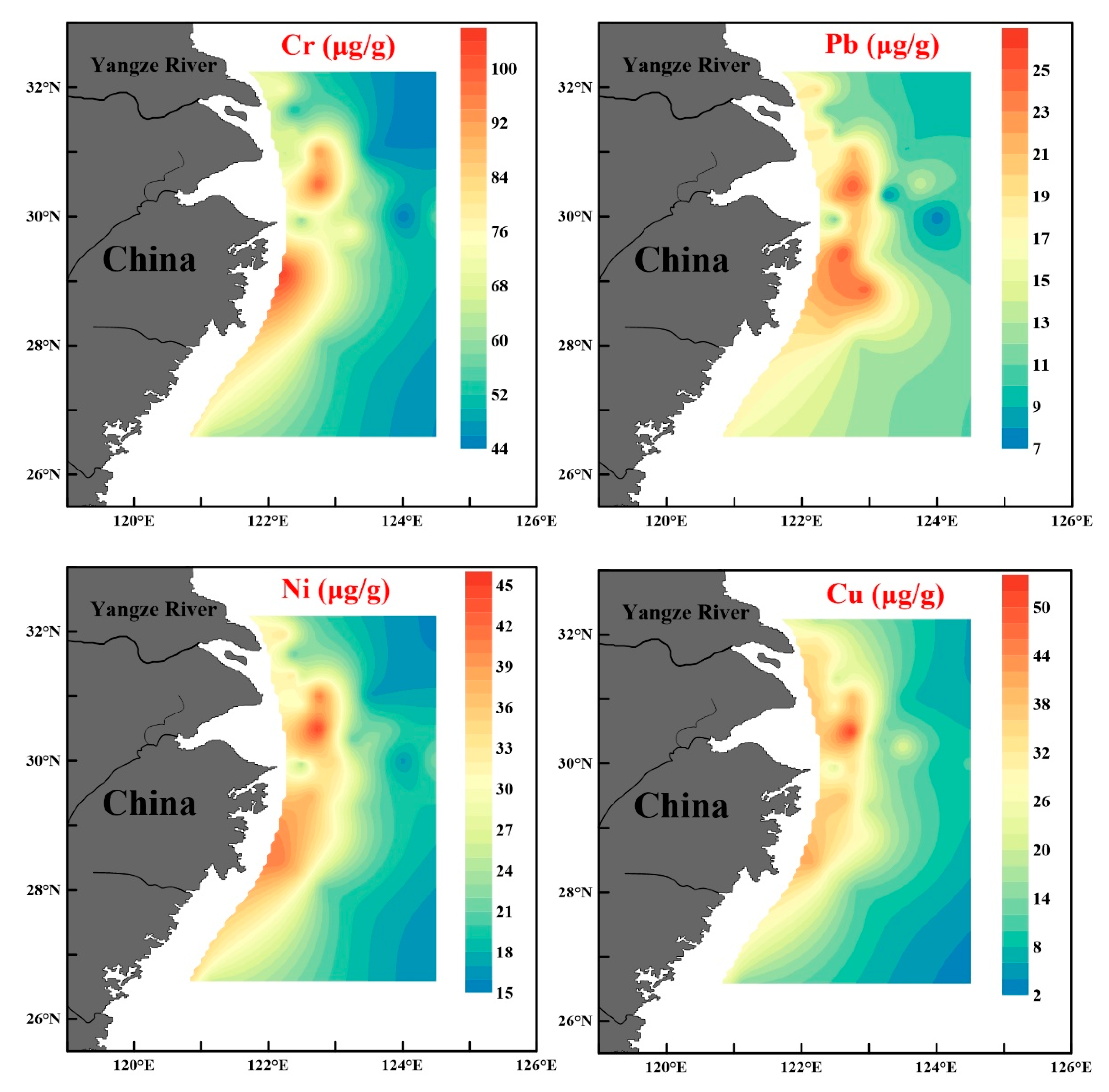
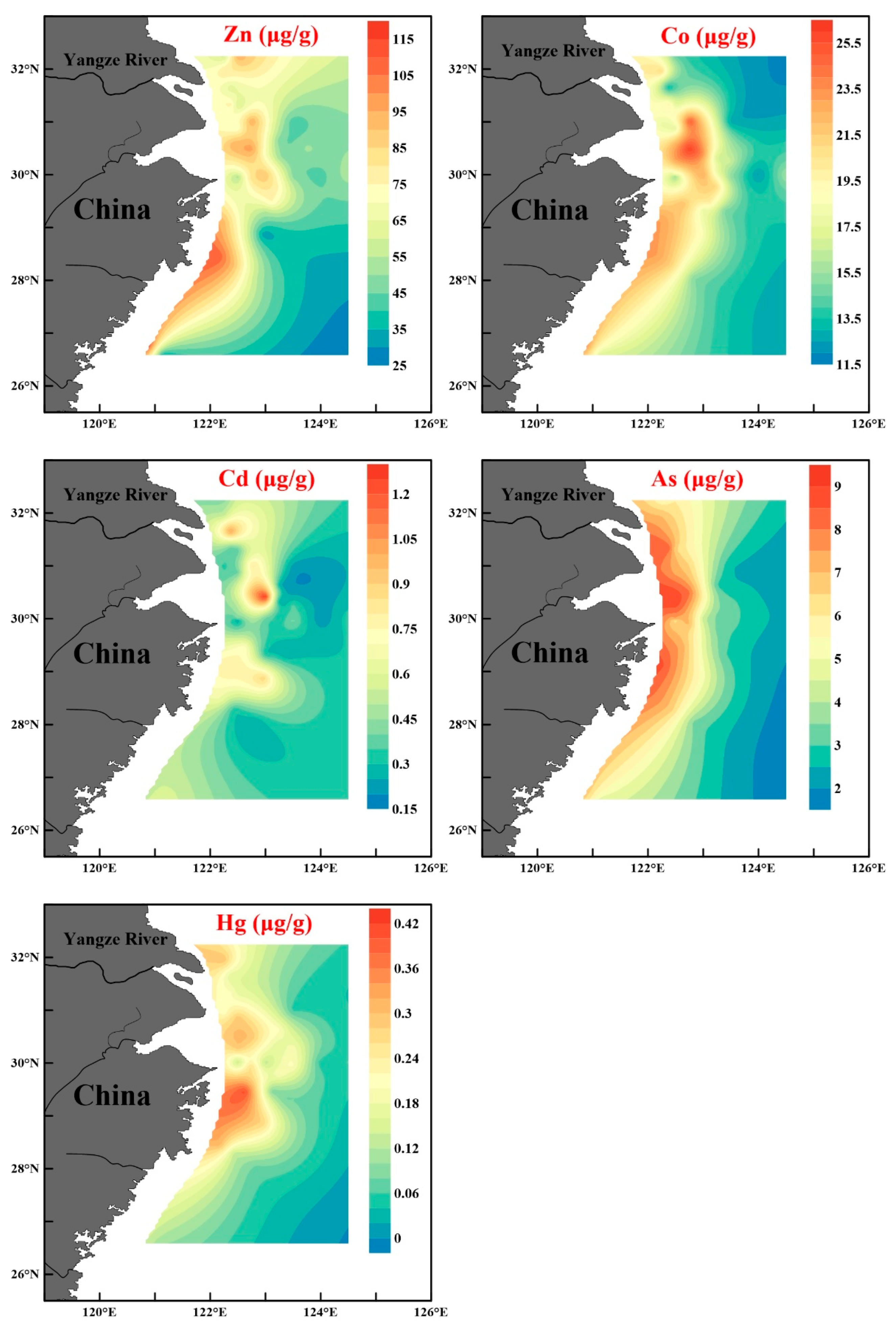
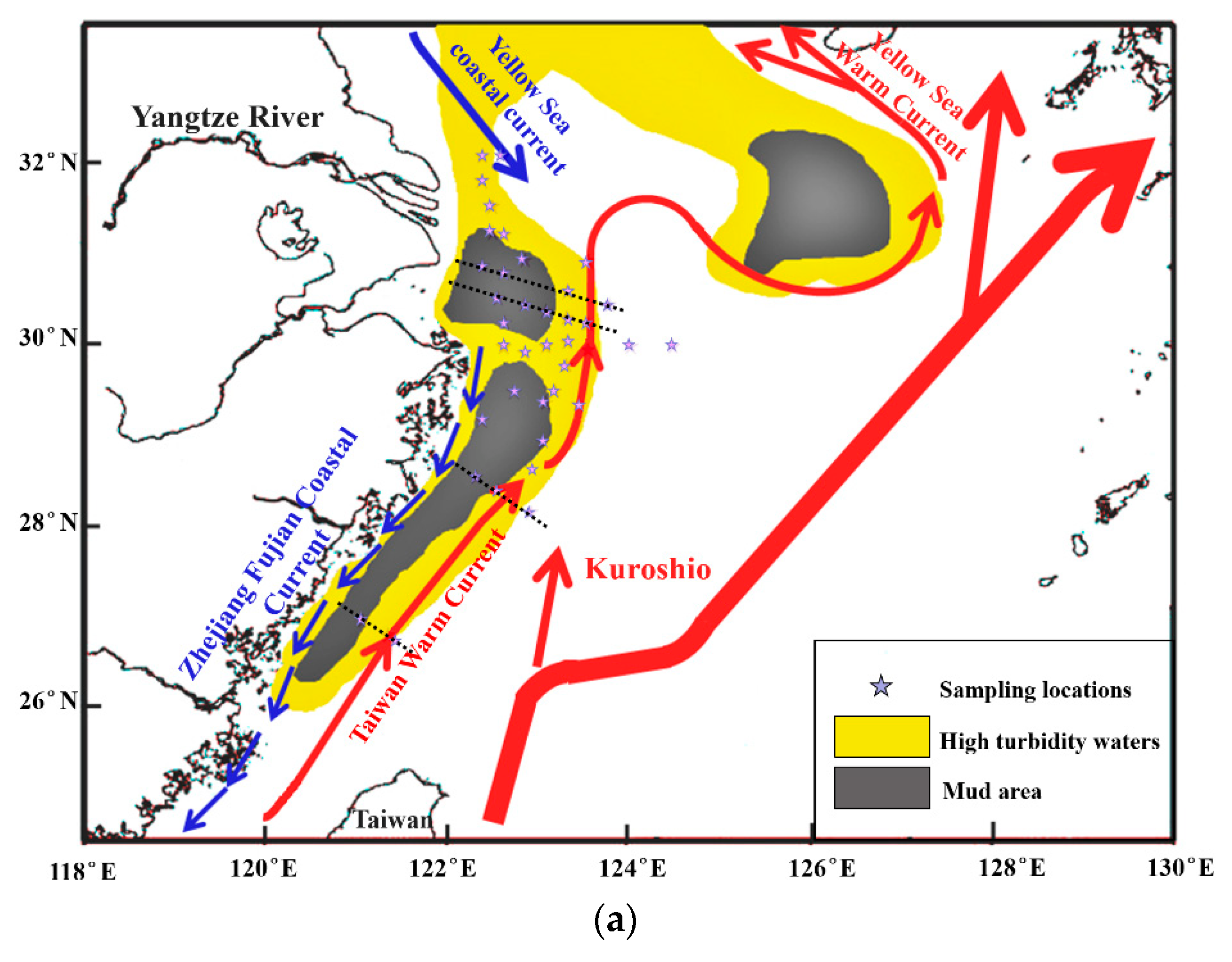
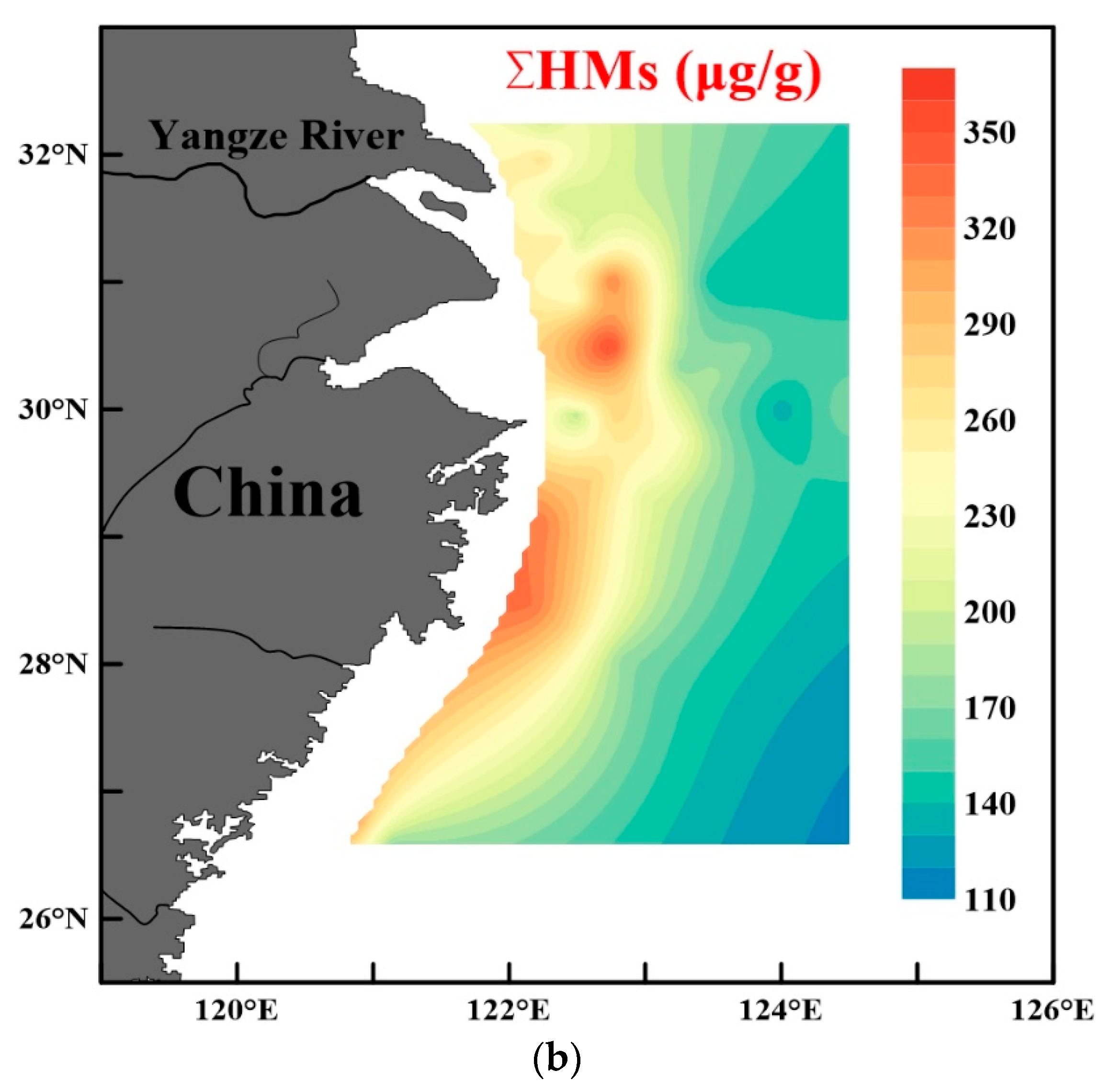
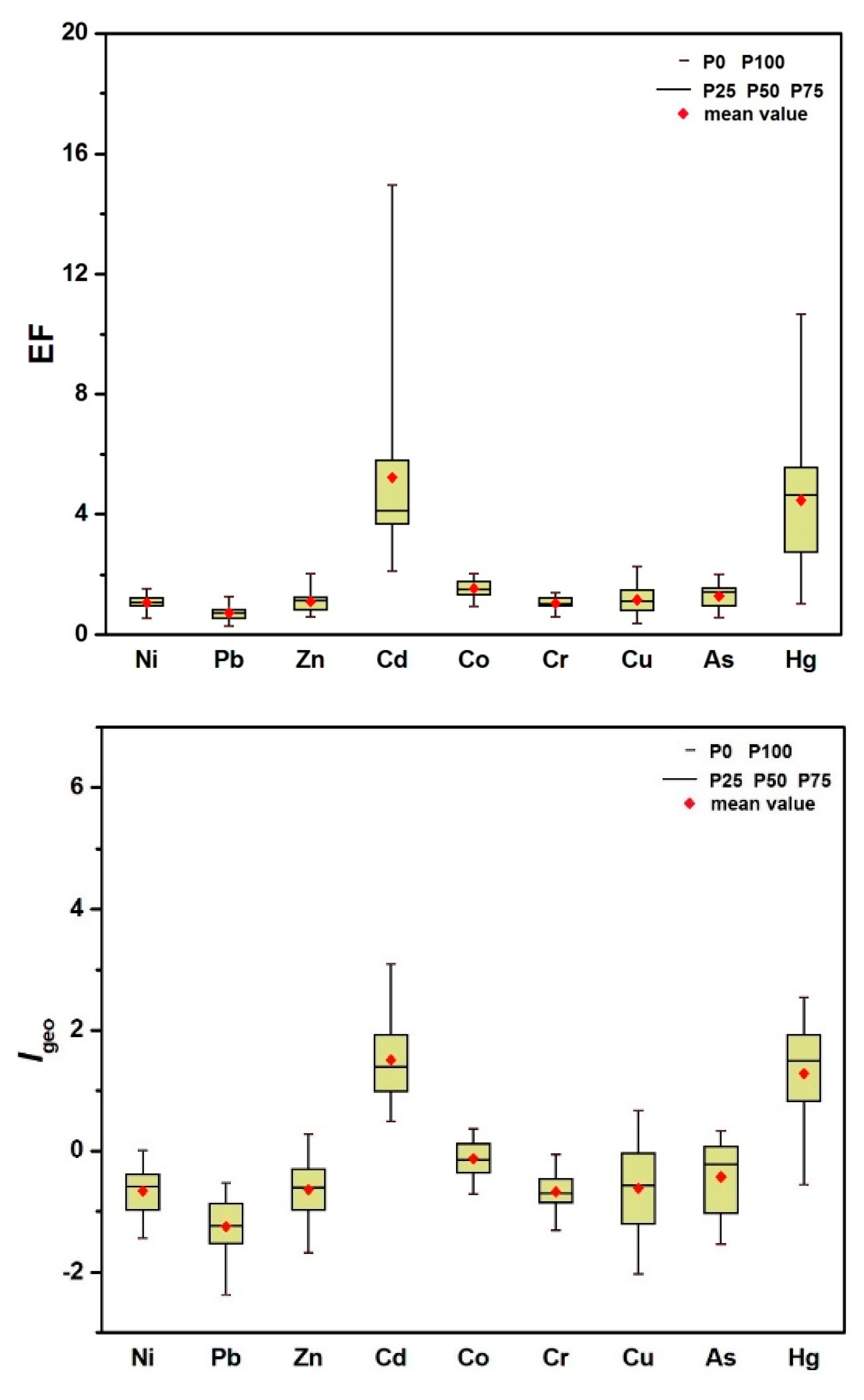
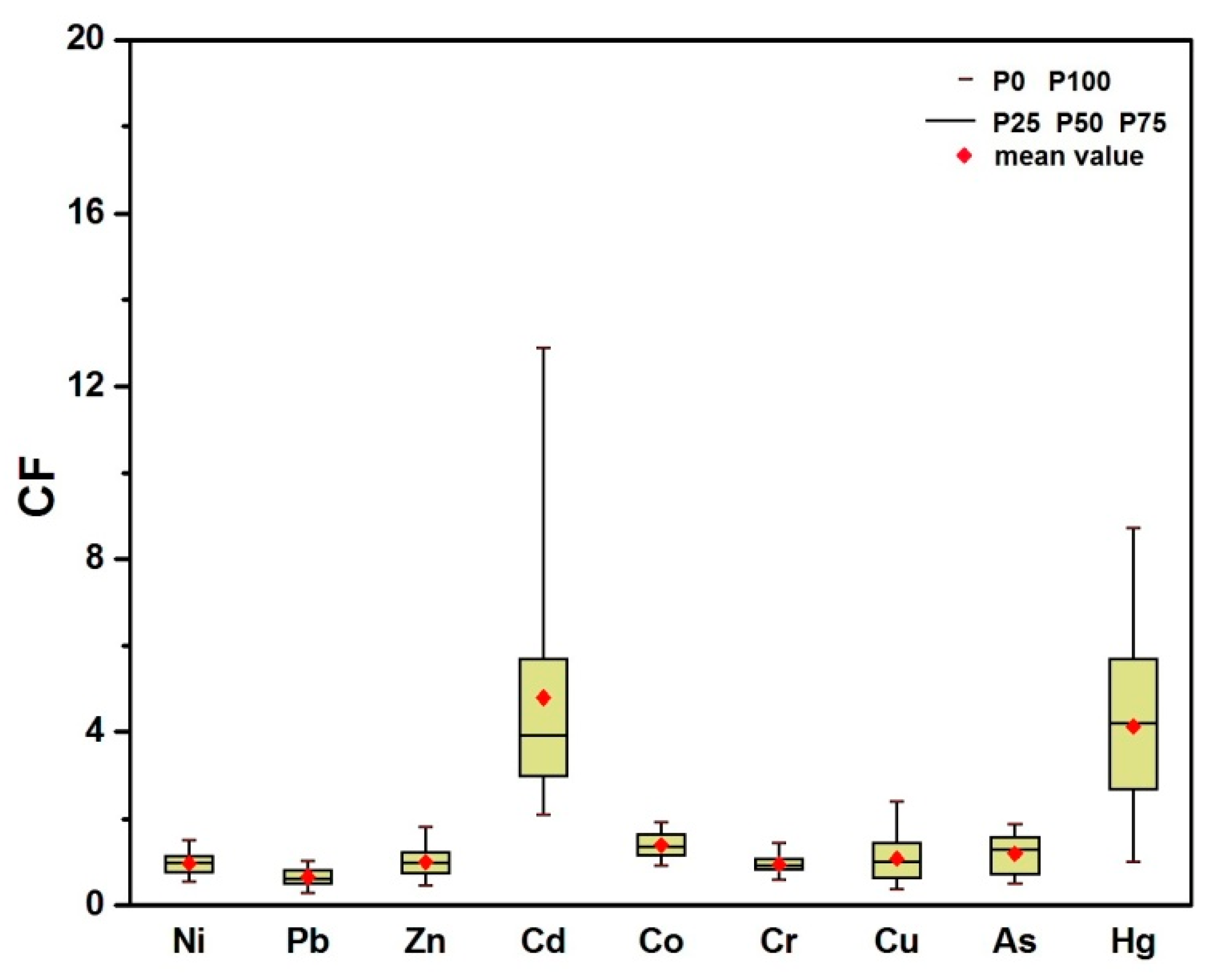
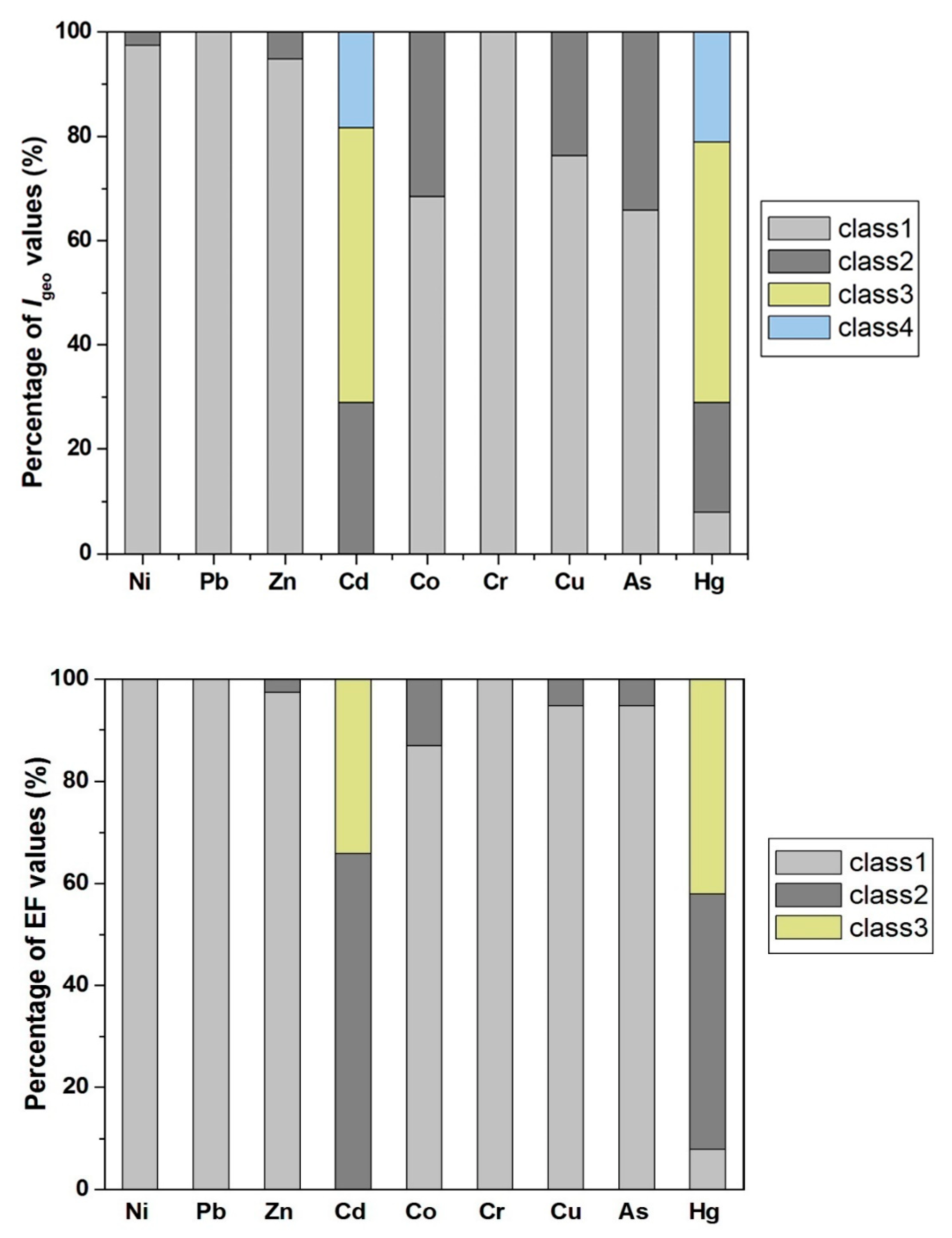
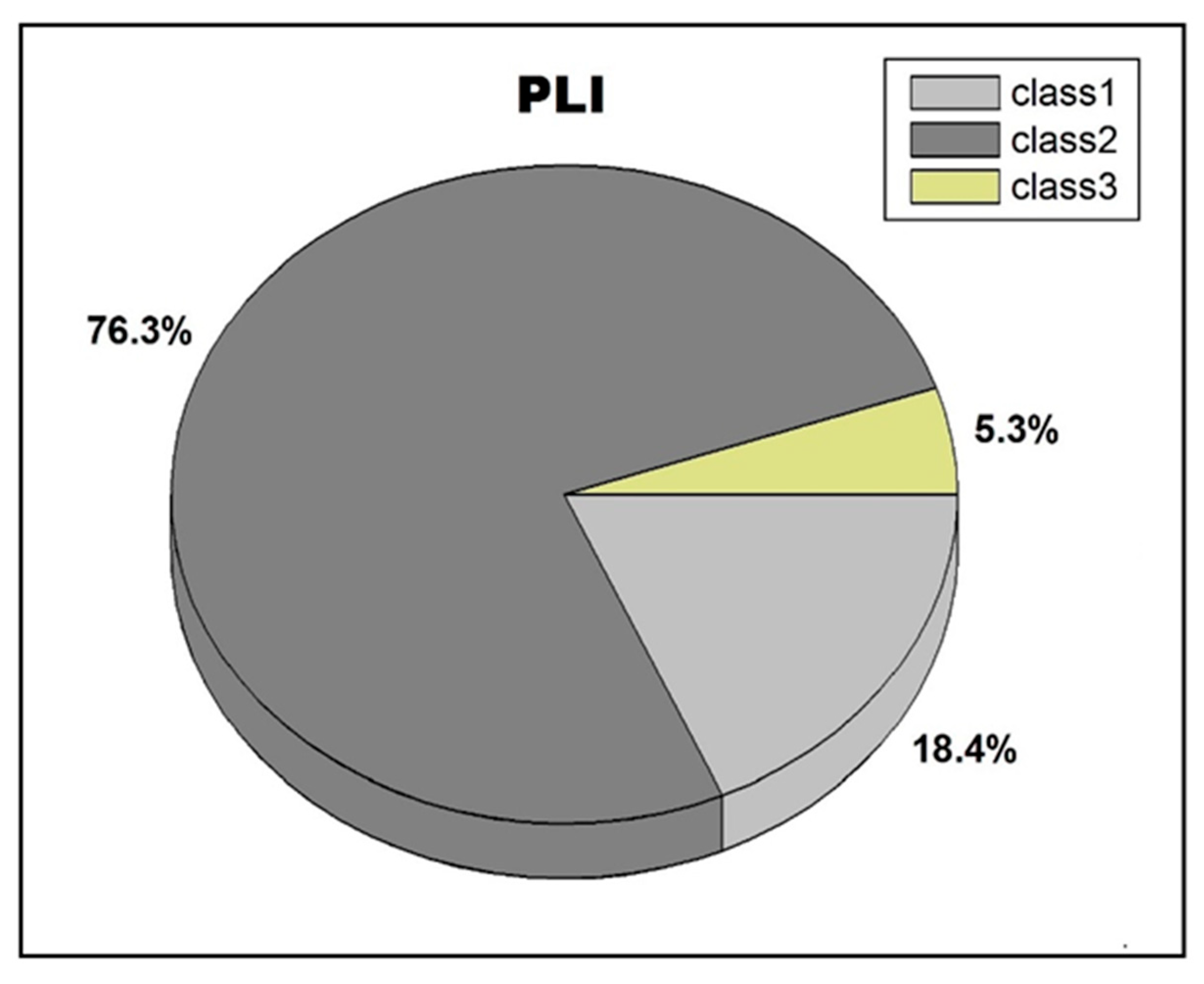
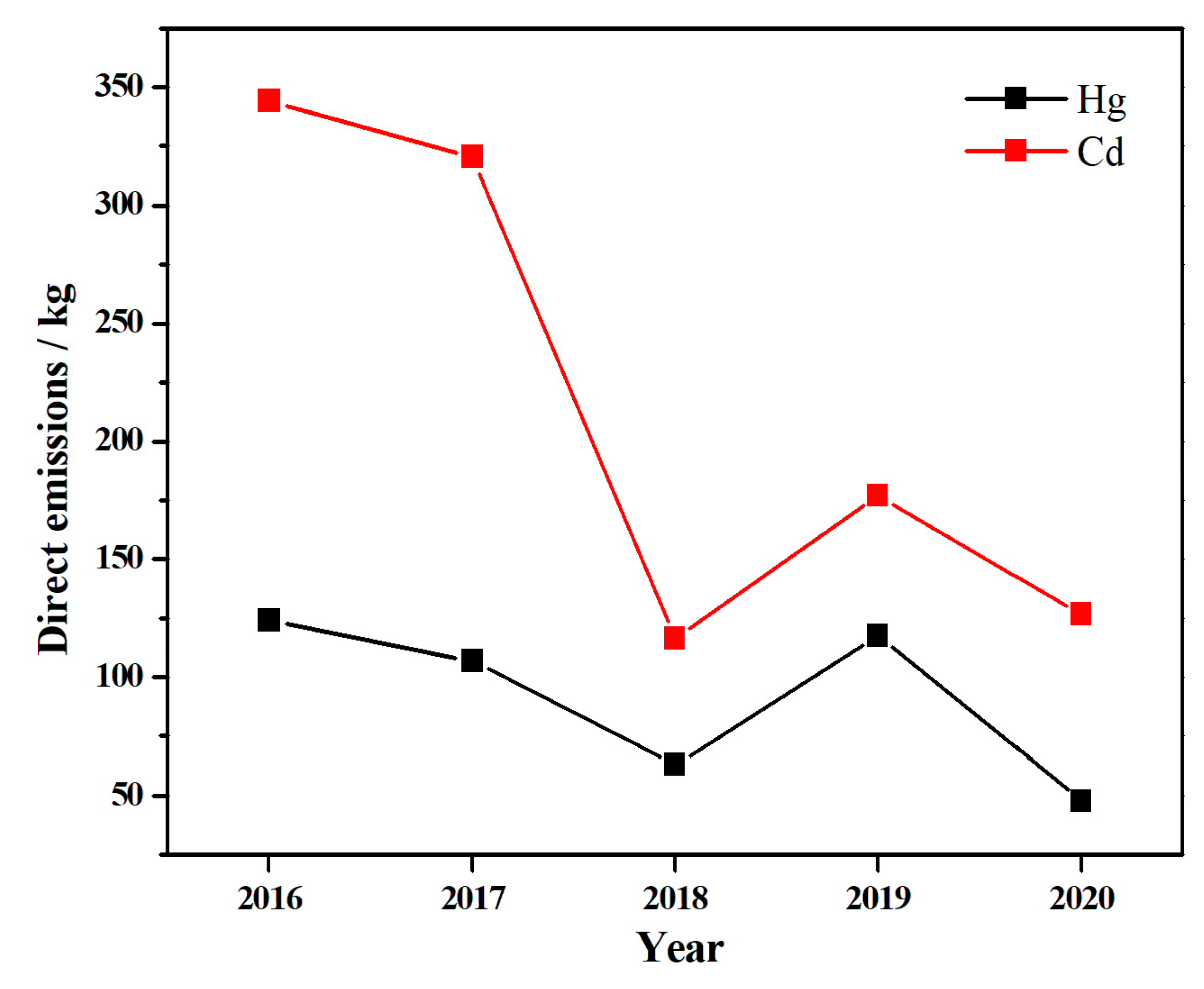
| Element | Linear Range (μg/g) | Linearity (R2) | LOQ (μg/g) | Recovery ± SD (%) | RSD (%) | Analytic Method |
|---|---|---|---|---|---|---|
| Pb | 0–50 | 0.9985 | 0.013 | 95.1 ± 3.1 | 3.26 | ICP-OES |
| Cr | 0–250 | 0.9997 | 0.004 | 99.2 ± 5.1 | 5.14 | ICP-OES |
| Ni | 0–100 | 0.9998 | 0.007 | 103.4 ± 1.4 | 1.35 | ICP-OES |
| Cu | 0–100 | 0.9985 | 0.003 | 97.5 ± 3.6 | 3.69 | ICP-OES |
| Zn | 0–500 | 0.9992 | 0.013 | 102.1 ± 2.5 | 2.45 | ICP-OES |
| Co | 0–100 | 0.9994 | 0.009 | 98.6 ± 2.9 | 2.94 | ICP-OES |
| Cd | 0–2.5 | 0.9999 | 0.001 | 101.4 ± 1.7 | 1.68 | ICP-OES |
| As | 0–25 | 0.9994 | 0.020 | 97.3 ± 3.9 | 4.01 | AFS |
| Hg | 0–1 | 0.9999 | 0.010 | 98.7 ± 2.7 | 2.74 | AFS |
| Classification | Enrichment Factor (EF) | Geoaccumulation Index (Igeo) | Potential Ecological Risk Index (Eri and RI) | ||||
|---|---|---|---|---|---|---|---|
| EF | Concentration Level | Igeo | Contamination Level | PLI | Contamination Level | ||
| class 1 | <2 | Depletion to minimal enrichment suggestive of no or minimal pollution | <0 | Practically unpolluted | ≤1 | No pollution | |
| class 2 | 2–5 | Moderate enrichment, suggestive of moderate pollution | 0–1 | Unpolluted to moderately polluted | 1–2 | Slight pollution | |
| class 3 | 5–20 | Significant enrichment, suggestive of a significant pollution signal | 1–2 | Moderate pollution | 2–3 | Moderate pollution | |
| class 4 | 20–40 | Very highly enriched, indicating a very strong pollution signal | 2–3 | Moderately to heavily polluted | >3 | High pollution | |
| class 5 | >40 | Extremely enriched, indicating an extreme pollution signal | 3–4 | Heavily polluted | |||
| class 6 | 4–5 | Heavily to extremely polluted | |||||
| class7 | ≥5 | Extremely polluted | |||||
| Statistics | Ni (μg/g) | Pb (μg/g) | Zn (μg/g) | Cd (μg/g) | Co (μg/g) | Cr (μg/g) | Cu (μg/g) | As (μg/g) | Hg (μg/g) | Al (μg/g) | Grain Size (μm) | TOC (%) |
|---|---|---|---|---|---|---|---|---|---|---|---|---|
| Minimum value | 16.45 | 7.04 | 31.93 | 0.21 | 12.32 | 43.77 | 8.34 | 2.39 | 0.05 | 6468 | 0.66 | 0.36 |
| Maximum value | 45.27 | 25.33 | 124.11 | 1.29 | 26.03 | 103.90 | 53.67 | 8.77 | 0.41 | 111,086 | 189.20 | 0.88 |
| Average value | 29.32 | 16.09 | 68.67 | 0.48 | 18.77 | 69.22 | 24.47 | 5.59 | 0.19 | 83,990 | 31.63 | 0.73 |
| Standard deviation | 7.29 | 4.94 | 21.45 | 0.26 | 3.63 | 13.95 | 11.13 | 2.07 | 0.09 | 12,480 | 42.40 | 0.11 |
| Variable coefficient (%) | 24.9 | 30.7 | 31.2 | 53.4 | 19.3 | 20.2 | 45.5 | 37.0 | 45.8 | 14.9 | 134.1 | 15.3 |
| Average value of the Changjiang River Estuary | 29.40 | 16.52 | 67.32 | 0.52 | 18.84 | 70.29 | 25.92 | 4.90 | 0.12 | 83,964 | 28.69 | 0.76 |
| Average value of the East China Sea | 29.14 | 15.03 | 71.97 | 0.38 | 18.60 | 66.60 | 20.89 | 5.86 | 0.23 | 84,052 | 38.83 | 0.67 |
| Ni | Pb | Zn | Cd | Co | Cr | Cu | As | Hg | Al | TOC | Crystallite Dimension | |
|---|---|---|---|---|---|---|---|---|---|---|---|---|
| Ni | 1 | 0.884 ** | 0.745 ** | 0.491 ** | 0.942 ** | 0.934 ** | 0.861 ** | 0.739 ** | 0.653 ** | 0.402 * | 0.209 | −0.467 ** |
| Pb | 1 | 0.546 ** | 0.593 ** | 0.825 ** | 0.832 ** | 0.762 ** | 0.643 ** | 0.699 ** | 0.329 * | 0.172 | −0.361 * | |
| Zn | 1 | 0.292 | 0.729 ** | 0.675 ** | 0.656 ** | 0.628 ** | 0.395 * | 0.263 | 0.121 | −0.295 | ||
| Cd | 1 | 0.490 ** | 0.557 ** | 0.578 ** | 0.498 ** | 0.520 ** | 0.328 * | 0.169 | −0.201 | |||
| Co | 1 | 0.925 ** | 0.725 ** | 0.587 ** | 0.586 ** | 0.360 * | 0.173 | −0.393 * | ||||
| Cr | 1 | 0.778 ** | 0.657 ** | 0.705 ** | 0.400 * | 0.209 | −0.384 * | |||||
| Cu | 1 | 0.866 ** | 0.708 ** | 0.477 ** | 0.288 | −0.434 ** | ||||||
| As | 1 | 0.668 ** | 0.258 | 0.295 | −0.472 ** | |||||||
| Hg | 1 | 0.226 | 0.405 * | −0.358 * | ||||||||
| Al | 1 | 0.077 | −0.098 | |||||||||
| TOC | 1 | −0.639 ** | ||||||||||
| Crystallite dimension | 1 |
| Location | Ni | Pb | Zn | Cd | Co | Cr | Cu | As | Hg | Sampling Time | Reference |
|---|---|---|---|---|---|---|---|---|---|---|---|
| The Changjiang River Estuary, China | 33.5 | 21.0 | 89.5 | 0.25 | - | 84.7 | 24.3 | 10.3 | 0.04 | 2007 | [30] |
| The Changjiang River Estuary, China | - | 21.70 | 63.92 | 0.58 | - | 26.57 | 10.41 | 0.110 | 2012–2016 | [31] | |
| The Changjiang River Estuary, China | - | 30.47 | 66.91 | 0.15 | - | 34.64 | 17.46 | 7.86 | 0.05 | 2014 | [29] |
| The Changjiang River Estuary and contiguous East China Sea | 29.3 | 16.1 | 68.7 | 0.48 | 18.8 | 69.2 | 24.5 | 5.59 | 0.19 | 2015 | In this study |
| The west Guangdong coastal region, China | - | 44.3 | 140 | 0.38 | - | 87.0 | 43.8 | 20.8 | 0.13 | 2008 | [43] |
| The Liaodong Bay, China | 22.5 | 31.8 | 71.7 | - | - | 46.4 | 19.4 | 8.30 | 0.04 | 2009 | [42] |
| The South Yellow Sea and northern part of the East Sea, China | 30.5 | 20.7 | 70.3 | - | - | 69.5 | 17.4 | - | - | 2009 | [44] |
| The Tupilipalem Coast, India | 6.43 | 5.67 | 14.2 | 0.71 | - | 9.25 | 3.55 | - | - | 2015 | [47] |
| The Red Sea, Saudi Arabia | 13.7 | 3.54 | 16.8 | - | 5.34 | 20.2 | 18.7 | - | 1.83 | 2018 | [20] |
| The Apulia region, Italy | 14.1 | 52.2 | 82.3 | 0.25 | - | 19.1 | 41.0 | 9.10 | 0.24 | 2010 | [46] |
| The Marmara Sea, Turkey | 49.1 | 32.9 | 85.5 | - | - | 115 | 39.3 | - | - | 2010 | [45] |
| PLI | Element | EF | Igeo | CF | ||||||||||||
|---|---|---|---|---|---|---|---|---|---|---|---|---|---|---|---|---|
| Maximum | Minimum | Maximum | Minimum | Maximum | Minimum | Maximum | Minimum | |||||||||
| Value | Site | Value | Site | Value | Site | Value | Site | Value | Site | Value | Site | Value | Site | Value | Site | |
| 2.26 | A14 | 0.67 | D3 | Ni | 1.5 | A24 | 0.1 | A14 | 0.01 | A14 | −1.45 | D3 | 1.5 | A14 | 0.6 | D3 |
| Pb | 1.3 | A24 | 0.1 | A14 | −0.53 | A14 | −2.37 | A16 | 1.0 | A24 | 0.3 | A16 | ||||
| Zn | 2.1 | D10 | 0.1 | A14 | 0.28 | D10 | −1.68 | A27 | 1.8 | D10 | 0.5 | A27 | ||||
| Cd | 15 | A15 | 0.9 | A14 | 3.10 | A15 | 0.49 | D3 | 12.9 | A15 | 2.1 | D3 | ||||
| Co | 2.1 | A8 | 0.2 | A14 | 0.37 | A14 | −0.71 | D3 | 1.9 | A14 | 0.9 | D3 | ||||
| Cr | 1.4 | A8 | 0.1 | A14 | −0.06 | A26 | −1.31 | D3 | 1.4 | A26 | 0.6 | D3 | ||||
| Cu | 2.1 | A24 | 0.2 | A14 | 0.67 | A14 | −2.02 | D3 | 2.4 | A14 | 0.4 | D3 | ||||
| As | 2.0 | A18 | 0.2 | A14 | 0.33 | A18 | −1.54 | D4 | 1.9 | A18 | 0.5 | D4 | ||||
| Hg | 11 | A24 | 0.6 | A14 | 2.54 | A24 | −0.56 | D3 | 8.7 | A24 | 1.0 | D3 | ||||
Disclaimer/Publisher’s Note: The statements, opinions and data contained in all publications are solely those of the individual author(s) and contributor(s) and not of MDPI and/or the editor(s). MDPI and/or the editor(s) disclaim responsibility for any injury to people or property resulting from any ideas, methods, instructions or products referred to in the content. |
© 2023 by the authors. Licensee MDPI, Basel, Switzerland. This article is an open access article distributed under the terms and conditions of the Creative Commons Attribution (CC BY) license (https://creativecommons.org/licenses/by/4.0/).
Share and Cite
Wang, Q.; Huang, X.; Zhang, Y. Heavy Metals and Their Ecological Risk Assessment in Surface Sediments of the Changjiang River Estuary and Contiguous East China Sea. Sustainability 2023, 15, 4323. https://doi.org/10.3390/su15054323
Wang Q, Huang X, Zhang Y. Heavy Metals and Their Ecological Risk Assessment in Surface Sediments of the Changjiang River Estuary and Contiguous East China Sea. Sustainability. 2023; 15(5):4323. https://doi.org/10.3390/su15054323
Chicago/Turabian StyleWang, Qianwen, Xiaoli Huang, and Yu’na Zhang. 2023. "Heavy Metals and Their Ecological Risk Assessment in Surface Sediments of the Changjiang River Estuary and Contiguous East China Sea" Sustainability 15, no. 5: 4323. https://doi.org/10.3390/su15054323





